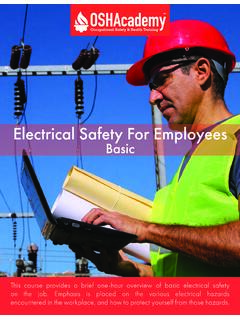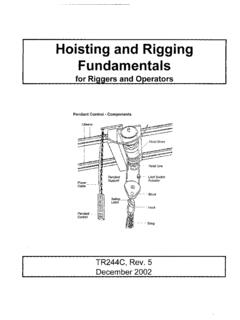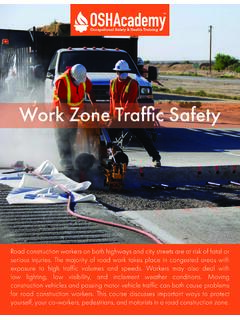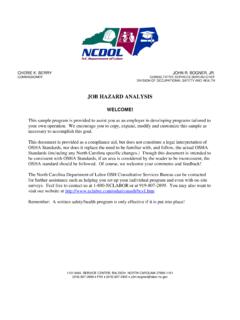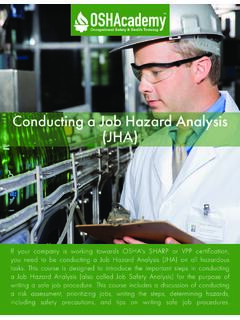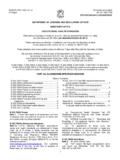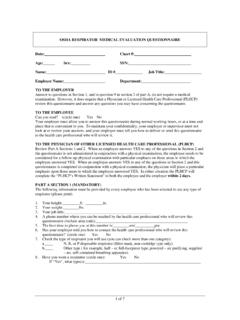Transcription of 750 Introduction to Industrial Hygiene
1 Introduction to Industrial Hygiene Industrial Hygiene is the science of anticipating, recognizing, evaluating, and controlling workplace conditions that may cause illness in the workplace. This training introduces how Industrial hygienists use environmental monitoring and analytical methods to detect the extent of worker exposure . How to employ engineering controls, work practice controls, and other methods to control potential workplace health hazards is also discussed. This page intentionally blank OSHA cademy Course 750 Study Guide Introduction to Industrial Hygiene Copyright 2021 Geigle Safety Group, Inc. No portion of this text may be reprinted for other than personal use. Any commercial use of this document is strictly forbidden. Contact OSHA cademy to arrange for use as a training document. This study guide is designed to be reviewed off-line as a tool for preparation to successfully complete OSHA cademy Course 750. Read each module, answer the quiz questions, and submit the quiz questions online through the course webpage.
2 You can print the post-quiz response screen which will contain the correct answers to the questions. The final exam will consist of questions developed from the course content and module quizzes. We hope you enjoy the course and if you have any questions, feel free to email or call: OSHA cademy 15220 NW Greenbrier Parkway, Suite 230. Beaverton, Oregon 97006. + Disclaimer This document does not constitute legal advice. Consult with your own company counsel for advice on compliance with all applicable state and federal regulations. Neither Geigle Safety Group, Inc., nor any of its employees, subcontractors, consultants, committees, or other assignees make any warranty or representation, either express or implied, with respect to the accuracy, completeness, or usefulness of the information contained herein, or assume any liability or responsibility for any use, or the results of such use, of any information or process disclosed in this publication. GEIGLE SAFETY GROUP, INC., DISCLAIMS ALL OTHER WARRANTIES EXPRESS OR IMPLIED INCLUDING, WITHOUT LIMITATION, ANY WARRANTIES OF.
3 MERCHANTABILITY OR FITNESS FOR A PARTICULAR PURPOSE. Taking actions suggested in this document does not guarantee that an employer, employee, operator or contractor will be in compliance with applicable regulations. Ultimately every company is responsible for determining the applicability of the information in this document to its own operations. Each employer's safety management system will be different. Mapping safety and environmental management policies, procedures, or operations using this document does not guarantee compliance regulatory requirements. Revised: March 1, 2021. Course 750. This page intentionally blank Course 750. Contents Course Introduction .. 1. What is Industrial Hygiene ? .. 1. Module 1: Industrial Hygiene and OSHA .. 3. How Are OSHA and Industrial Hygiene Related? .. 3. Worksite Analysis .. 4. Recognizing and Controlling Hazards .. 5. The Hierarchy of Controls .. 6. Reducing Exposures .. 7. Module 2: Air Contaminants .. 9. Indoor Air 10. Acute Health Effects of Major Indoor Air Contaminants.
4 11. Outdoor Air 16. Six Common Outdoor Air Pollutants .. 16. Module 3: Chemical Hazards .. 20. Introduction .. 20. Toxic and Hazardous Chemicals .. 20. What makes a chemical toxic?.. 20. Are "toxic" and "hazardous" the same? .. 21. Why are some chemicals more harmful than others? .. 21. Routes of exposure .. 22. Inhalation .. 22. Skin Contact .. 22. Eye Contact .. 23. Course 750. 23. Toxicity of Chemicals .. 23. Dose: How much is too much? .. 23. Duration: How long is too long? .. 24. Latency: How long does it take for a toxic effect to occur? .. 25. Differences between acute and chronic effects .. 26. Reaction and interaction: What if you're exposed to more than one chemical? .. 27. Sensitivity: Are some people more affected than others? .. 27. How can toxic substances harm the body? .. 28. What are the different forms of toxic materials? .. 29. 30. Liquid .. 30. 30. Vapor .. 30. Dust .. 30. Fume .. 31. Fiber .. 31. Mist .. 31. exposure Limits .. 31. Monitoring and Measuring exposure .
5 33. Air/Environmental Monitoring .. 33. Biological Monitoring .. 33. Practical clues to exposure .. 34. Module 4: Biological 36. Course 750. Introduction .. 36. Biological Agents .. 36. 37. Avian Flu .. 37. Bloodborne Pathogens and Needlestick Prevention .. 37. Botulism .. 37. Foodborne Disease .. 38. Hantavirus .. 38. Legionnaires' disease .. 38. Mold .. 38. 38. Ricin .. 39. Severe Acute Respiratory Syndrome (SARS) .. 39. Smallpox .. 39. Tularemia .. 39. Viral Hemorrhagic Fevers (VHFs) .. 39. Possible Risks and Suggested Measures .. 40. Module 5: Physical Hazards .. 45. Ionizing & Non-Ionizing Radiation .. 47. Nonionizing Radiation .. 47. Ionizing 48. Noise .. 49. How does the ear work? .. 50. What are the warning signs that your workplace may be too noisy? .. 50. Course 750. How loud is too loud? .. 51. Reducing Noise 52. Engineering Controls .. 52. Administrative Controls .. 53. 53. Hearing Conservation 53. Personal Protective Equipment .. 53. Vibration .. 54. Potential Hazards.
6 54. Raynaud's 54. Possible Solutions .. 55. Illumination .. 56. Heat .. 58. Office Temperature/Humidity .. 58. Non-Office Work 58. Engineering Controls .. 59. General Ventilation .. 59. Air treatment/air cooling .. 59. Fans .. 60. Shields .. 60. Insulation .. 60. Administrative Controls and Work Practices .. 60. Training .. 61. Module 6: Ergonomic Hazards .. 63. Course 750. Ergonomic Guidelines .. 64. Basic Ergonomic Principles .. 65. Ergonomic Injuries .. 66. Classifications of Ergonomic Injuries .. 66. Early Reporting of Ergonomic Issues .. 67. Proactive Reporting .. 67. Early Reporting Process .. 67. Benefits to Early Reporting .. 67. Stretching Basics .. 68. Ergonomic Risk Factors .. 70. Course 750. This page intentionally blank Course 750. Course Introduction What is Industrial Hygiene ? Industrial Hygiene is the science of anticipating, recognizing, evaluating, and controlling workplace conditions that may cause workers' injury or illness. Industrial hygienists use environmental monitoring and analytical methods to detect the extent of worker exposure and employ engineering, work practice controls, and other methods to control potential health hazards.
7 There has been an awareness of Industrial Hygiene since antiquity. The environment and its relation to worker health were recognized as early as the fourth century BC when Hippocrates noted lead toxicity in the mining industry. In the first century AD, Pliny the Elder, a Roman scholar, perceived health risks to those working with zinc and sulfur. He devised a face mask made from an animal bladder to protect workers from exposure to dust and lead fumes. In the second century AD, the Greek physician, Galen, accurately described the pathology of lead poisoning and also recognized the hazardous exposures of copper miners to acid mists. In the Middle Ages, guilds worked at assisting sick workers and their families. In 1556 the German scholar, Agricola, advanced the science of Industrial Hygiene even further when, in his book De Re Metallica, he described the diseases of miners and prescribed preventive measures. The book included suggestions for mine ventilation and worker protection, discussed mining accidents, and described diseases associated with mining occupations such as silicosis.
8 Industrial Hygiene gained further respectability in 1700 when Bernardo Ramazzini, known as the "father of Industrial medicine," published in Italy the first comprehensive book on Industrial medicine, De Morbis Artificum Diatriba (The Diseases of Workmen). The book contained accurate descriptions of the occupational diseases of most of the workers of his time. Ramazzini greatly affected the future of Industrial Hygiene because he asserted that occupational diseases should be studied in the work environment rather than in hospital wards. Industrial Hygiene received another major boost in 1743 when Ulrich Ellenborg published a pamphlet on occupational diseases and injuries among gold miners. Ellenborg also wrote about the toxicity of carbon monoxide, mercury, lead, and nitric acid. In England in the 18th century, Percival Pott, as a result of his findings on the insidious effects of soot on chimney sweepers, was a major force in getting the British Parliament to pass the Copyright 2021 Geigle Safety Group, Inc.
9 Page 1 of 71. Course 750. Chimney-Sweepers Act of 1788. The passage of the English Factory Acts beginning in 1833 marked the first effective legislative acts in the field of Industrial safety. The Acts, however, were intended to provide compensation for accidents rather than to control their causes. Later, various other European nations developed workers' compensation acts, which stimulated the adoption of increased factory safety precautions and the establishment of medical services within Industrial plants. In the early 20th century in the United States, Dr. Alice Hamilton led efforts to improve Industrial Hygiene . She observed Industrial conditions first hand and startled mine owners, factory managers, and state officials with evidence there was a correlation between worker illness and their exposure to toxins. She also presented definitive proposals for eliminating unhealthful working conditions. At about the same time, federal and state agencies began investigating health conditions in industry.
10 In 1908, the public's awareness of occupationally related diseases stimulated the passage of compensation acts for certain civil employees. States passed the first workers'. compensation laws in 1911. And in 1913, the New York Department of Labor and the Ohio Department of Health established the first state Industrial Hygiene programs. All states enacted such legislation by 1948. In most states, there is some compensation coverage for workers contracting occupational diseases. The Congress has passed three landmark pieces of legislation relating to safeguarding workers' health: (1) the Metal and Nonmetallic Mines Safety Act of 1966, (2) the Federal Coal Mine Safety and Health Act of 1969, and (3) the Occupational Safety and Health Act of 1970 (Act). Today, nearly every employer is required to implement the elements of an Industrial Hygiene and safety, occupational health, or hazard communication program and to be responsive to the Occupational Safety and Health Administration (OSHA) and the Act and its regulations.

